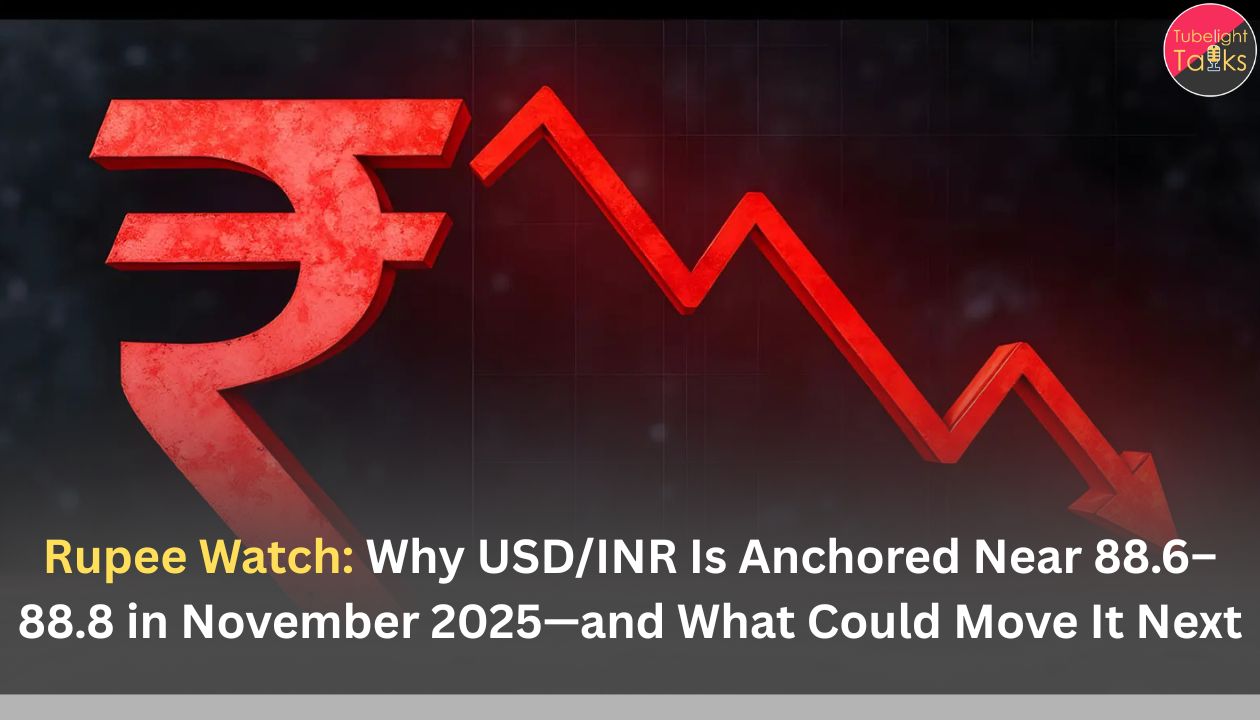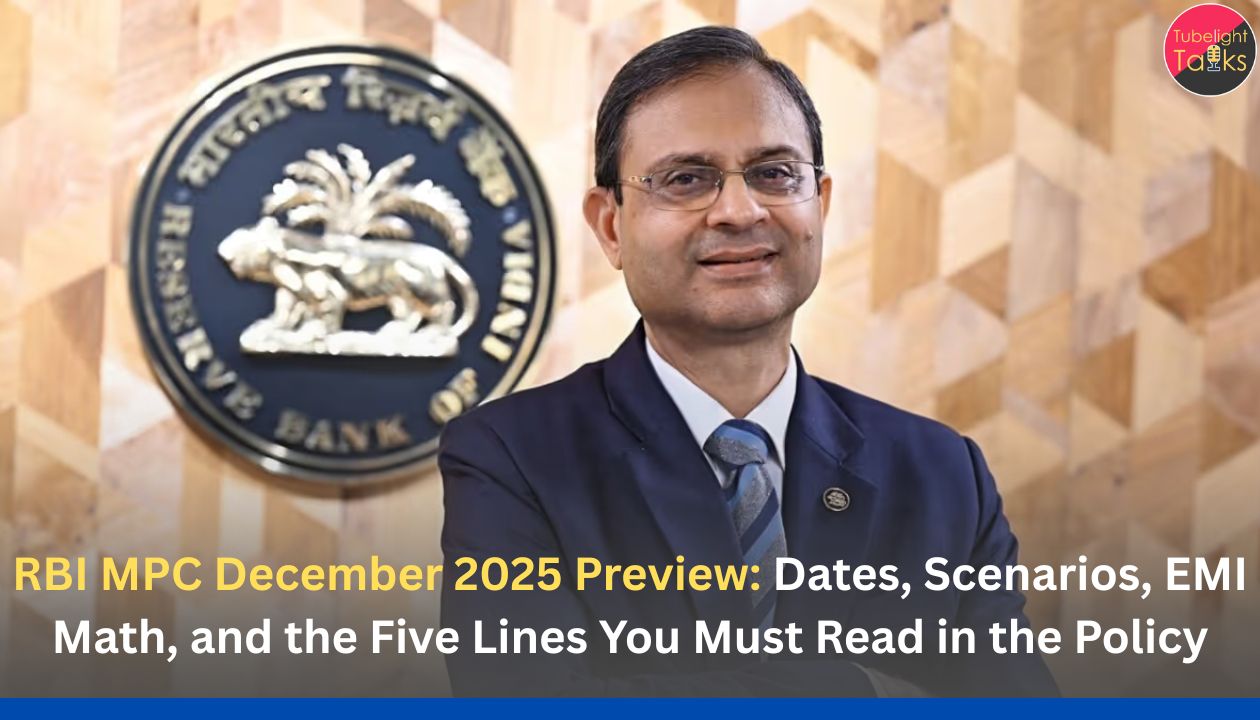Rupee Watch: Through the first half of November 2025, the rupee has traded tightly around 88.6–88.8 per U.S. dollar, brushing its late-September record low but largely holding the line. Daily reference prints and interbank closes show narrow ranges as a familiar mix of factors pull in oppo
site directions: RBI defence via state-run banks, oil in the mid-$60s, a Dollar Index near 100, mixed FPI flows, and anxiety around trade policy.
This explainer pieces together the on-ground price action, the central-bank playbook, the macro drivers, and the week-ahead risks—using FBIL/RBI reference data and Reuters market coverage so you can update newsroom copy or make better treasury calls.
Where USD/INR Actually Traded This Week (with official prints)
- FBIL/RBI reference rates show USD/INR around 88.79 on Nov 3 and 88.72 on Oct 31, consistent with the interbank “88-handle” narrative. These are standardized daily benchmarks used across the street.
- Interbank closes reported by Reuters clustered at 88.78 on Nov 3, 88.66 on Nov 4, and 88.61 on Nov 6, reflecting small day-to-day moves but a stubbornly narrow band.
The “defended” zone around the all-time low
Multiple Reuters notes describe state-run banks offering dollars on behalf of the RBI near 88.65–88.80, a pattern reminiscent of October when traders repeatedly saw the central bank lean against a breach of ~88.80–89.00. This is textbook “leaning-against-the-wind” to smooth volatility, not fix a level.
“The rupee rebounded… likely due to early intervention by the RBI,” with traders citing pre-open action that “defended the 89 level.” — Reuters, Nov 4.
The Four Big Forces Holding the Rupee in Place
1) Central-bank playbook: intervene, then manage liquidity
Reports through Oct–Nov show frequent RBI presence near the lows, occasionally before spot market open to amplify impact in thin liquidity. A mid-Oct piece also flagged FX interventions as a reason domestic rupee liquidity needed later adjustment—classic two-step: defend INR → re-add rupee liquidity via money-market ops.
2) Oil isn’t the enemy—for now
Brent has hovered around the mid-$60s after OPEC+ paused planned Q1 output hikes. That keeps India’s oil import bill manageable versus the $80–90 regimes that usually pressure the rupee. Energy desks call the pause a response to surplus risks, with sanctions noise on Russia adding volatility—but the level today is a tailwind vs history.
3) The dollar is firm, but not roaring
The Dollar Index (DXY) is sitting close to ~100 (99.5–100.2 in recent closes). A stable dollar adds background pressure to EM FX, but not the kind of squeeze seen during 2022–23 surges. That helps RBI’s task: resisting a break at 88.8 is far easier if DXY is below 103.
4) Flows are mixed, not one-way
Foreign portfolio investors (FPI) have sold equities in November to date, but not in a disorderly way, and debt flows have been steadier. Net-net, there’s no single floodgate pushing USD/INR beyond the lows—another reason the pair is stuck.
What’s Pushing the Other Way (and why the break keeps failing)
Trade gap noise and tariff uncertainty
Headlines flagged a wider merchandise trade deficit into September and ongoing U.S.–India tariff uncertainty. Typically, a bigger deficit fuels dollar demand from importers; yet intervention and oil’s softness have offset the impulse—hence “volatility without follow-through.”
Importer demand at every dip
Desk colour: whenever USD/INR slips under 88.50, importers tend to “top up,” pulling the pair back up. Reuters repeatedly notes foreign banks and importer bids on intraday declines. That buying caps INR rallies, keeping the band tight.
Anatomy of the Band: How 88.5–88.8 Became “Home Base”
- Top rail (~88.80–89.00): widely seen as the RBI’s pain threshold for optics and expectations; the all-time low sits here, so optics matter.
- Mid rail (~88.60–88.65): where state-run bank offers and importer demand often meet; several Reuters closes cluster here.
- Lower rail (~88.40–88.50): stop-loss pockets and exporter supply can emerge, but FPI equity outflows limit sustained INR strength.
Week-Ahead Drivers to Watch
1) CPI print & RBI optics
If CPI (Oct) lands ultra-low (release due Nov 12), rupee-bulls may test 88.4–88.5 again on softer real-rate concerns. But the RBI has signalled neutral stance and prefers measured moves—so one CPI won’t set policy in stone. (See our CPI preview and Oct policy explainer.)
2) Oil’s path after OPEC+
A further drift toward low-$60s Brent is INR-positive; any supply shock would reverse that. Keep a tab on OPEC+ commentary and shipping incidents; recent headlines have punctuated otherwise soft prices.
3) DXY vs U.S. yields
With DXY ~100, a soft U.S. data surprise could ease the dollar and help INR without RBI spending reserves. Conversely, a hawkish jolt takes us back to the 88.7–88.8 edge fast.
4) FPI flows and tariff signals
Another equity outflow week like early-Nov weighs on INR at the margin; any tariff de-escalation headlines could flip positioning quickly (remember Goldman’s tactical bullish INR call).
How Treasury Teams Should Read the Microstructure
RBI’s “old playbook,” updated
Traders talk about RBI pre-open nudges and intraday smoothing via state-run banks, then liquidity calibration afterward. This sequence kept the pair range-bound for two weeks in October and seems alive in November. Pricing your hedges without acknowledging this is asking for slippage.
The forward curve tells a story
Nov 6 reportage noted one-year forward implied yields ~2.1%, the lowest in 2+ months—a sign of calmer FX vol and lower carry. That makes long-dated hedges cheaper to roll, but you sacrifice upside if INR rips stronger on policy or oil.
Importers vs exporters
- Importers: layer buys in 88.45–88.60; don’t wait for perfect 88.20s that rarely print without news.
- Exporters: scale partial sells near 88.75–88.80 if books allow; leave some optionality in case of a break lower (INR stronger).
That’s been the pragmatic rhythm of the last fortnight, looking at intraday colour and closes.
Macro Context in One Page
Oil, DXY, growth, and policy
- Oil: mid-$60s reduces India’s terms-of-trade stress.
- DXY: around ~100, not in panic territory.
- Growth/Policy: RBI held repo 5.50% (neutral) on Oct 1, cut FY26 CPI forecast and raised GDP—dovish optics, but still cautious. (See our dedicated explainer.)
- Flows: FPIs turned net sellers in Nov; not a stampede, but a headwind for rupee rallies.
Trade balance & gold
The gold/silver import impulse widened the trade deficit in September, usually a rupee negative. Without oil pain, the net effect is manageable but bears watching into wedding season.
Two-Week Scenarios (Nov 10–24, IST)
Scenario A: The “soft inflation + soft oil” glide (55% odds)
- What happens: CPI underwhelms, Brent drifts, DXY softens.
- USD/INR: probes 88.40–88.50; RBI buys dollars to rebuild reserves on dips, capping INR strength.
- Strategy: Importers pre-hedge 50%; exporters sell on upticks with small options overlays.
Scenario B: “Tariff noise + FPI outflows” wobble (30% odds)
- What happens: Trade headlines worsen; equities bleed modestly.
- USD/INR: retests 88.75–88.85; RBI defends again.
- Strategy: Importers layer buys higher; exporters stay patient for 88.80 spikes.
Scenario C: “Shock risk-off” (15% odds)
- What happens: Global risk-off and a firmer DXY push Asian FX weaker.
- USD/INR: attempts 89+; RBI intervention intensifies; forwards cheapen as vol rises.
- Strategy: Importers secure cover on breach; exporters stagger sales and consider collars.
What Could Break the Range (and How to Respond)
A surprise surge in oil
A geopolitical flare-up sends Brent toward $75–80: importers should front-load cover; exporters widen collars to capture spikes.
A DXY spike on U.S. data
If DXY rips above 102–103, expect INR to be back at 88.8–89.0 quickly; RBI to lean harder, forwards widen; importers step up spot cover.
Flow shock
A large FPI equity exit day or gold import surge can pressure INR intraday; count on state-run banks near the lows, but don’t gamble your payables.
Stability with Stewardship
In currency markets, stability isn’t only about numbers—it’s about responsibility. When prices are calm, treasurers and business owners can choose fair dealing: pass benefits through supply chains, pay on time, and avoid exploitative pricing during volatile weeks. Spiritual discourses from Sant Rampal Ji Maharaj often emphasise honest earnings, truthful conduct, and consideration for others—habits that build trust in markets and workplaces alike.
For a values-first lens on day-to-day decisions (from pricing to payroll), explore his talks and the book “Way of Living”, both of which connect prosperity with righteous conduct.
Make Calm Weeks Count
Hedge smart, communicate clearly, and be ready for both sides of 88.6
- Lock a policy: Define bands (88.4 / 88.65 / 88.85) and stick to them; avoid ad-hoc FX calls.
- Use official anchors: Quote FBIL/RBI for your board packs; annotate with Reuters closes for colour.
- Pre-agree playbooks: If Brent >$75 or DXY >102, trigger extra cover; if CPI surprises lower, allow INR-friendly optionality.
- Be fair: When FX and input costs ease, share the relief—ethics compound into customer loyalty.
Read Also: India’s Forex Reserves Fall by $5.6 Billion to $689.73 Billion Amid Currency Market Pressure
FAQs: Rupee Watch USD/INR steady near 88.6–88.8. Why?
Q1. What was USD/INR around Nov 3–6, 2025?
Reference prints were about 88.79 (Nov 3) and 88.72 (Oct 31); interbank closes sat near 88.78 (Nov 3), 88.66 (Nov 4), 88.61 (Nov 6).
Q2. Is RBI really defending 88.8?
Reuters reports persistent state-run bank offers and pre-open action near the all-time low, consistent with volatility-smoothing rather than a hard peg.
Q3. What are DXY and Brent doing? Why do they matter?
DXY ~100 keeps background dollar strength modest; Brent ~mid-$60s reduces India’s oil stress—both supportive for INR stability.
Q4. Are FPIs buying or selling?
Net equity outflows have resumed in November so far, a mild headwind for INR rallies.
Q5. What could break the range?
A sharp oil spike, a DXY jump, or a flow shock (FPI or gold imports) could push USD/INR toward or past 89; the RBI has historically leaned against disorderly moves.
Q6. Where do I get official daily rates?
Use FBIL/RBI reference rates; many market portals (e.g., NSE’s page) mirror the daily archive.










